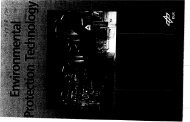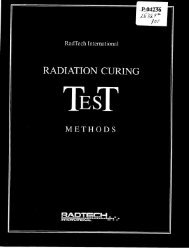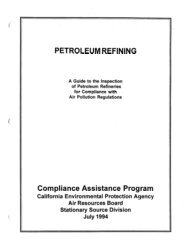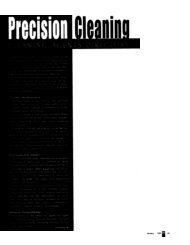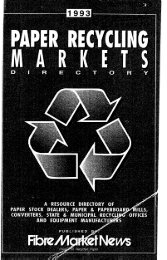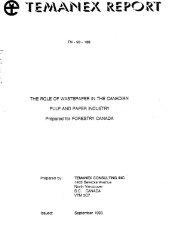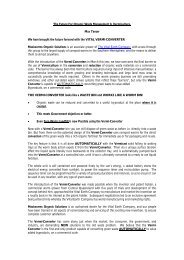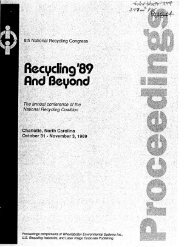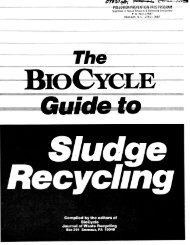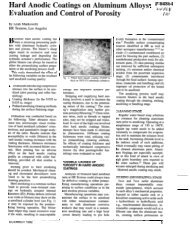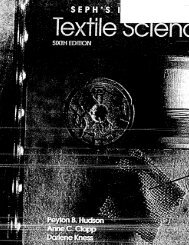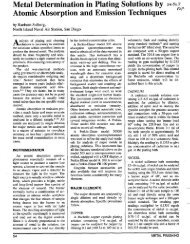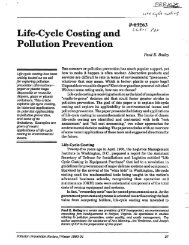Electronic Parts/Guidelines - infoHouse
Electronic Parts/Guidelines - infoHouse
Electronic Parts/Guidelines - infoHouse
Create successful ePaper yourself
Turn your PDF publications into a flip-book with our unique Google optimized e-Paper software.
7<br />
SALVAGE<br />
a quantity of materials, sometimes of<br />
mixed composition, no longer useful in its<br />
present condition or at Its present location,<br />
but capable of being recycled, reused, or<br />
used in other applications. Salvage also<br />
refers io materials recovered after a<br />
calamity, such as materials obtained from<br />
a ship wrecked at sea or a building<br />
destroyed by flre.<br />
SALVAGE<br />
the act of saving or obtaining a secondary<br />
material, be it by pickup, sorting, disassembly,<br />
or some other activity.<br />
SANITARY LANDFILL<br />
a controlled method of disposing of refuse<br />
on land without creating nuisances or<br />
hazards to public health or safety, by utilizing<br />
the principles of engineering to<br />
confine the refuse to the smallest practical<br />
area, to reduce it to the smallest practical<br />
volume and to cover it with a layer of earth<br />
at the conclusion of each day's operation<br />
or at more frequent intervals. The technique<br />
includes careful preparation of the fill<br />
area, control of leachate and a specifled<br />
volume of dirt to be spread over each<br />
volume of trash. (I)<br />
SANITATION<br />
the control of all the factors in man's physical<br />
environment that exercise or can exercise<br />
a deleterious effect on his physical<br />
development, health, and survival. (I)<br />
SCAVENGER<br />
one who illegaliy removes materials at any<br />
point In the solid waste management<br />
system. (7)<br />
SCRAP<br />
I. Any solid trim, cutting or reject material<br />
which may be suitable as feedstock to the<br />
primary operation. lnplant or preconsumer<br />
waste. 2. Discarded or rejected industrial<br />
~. .. . ~--_~_-1?L.~<br />
~ .....<br />
waste material often suitable for recycling.<br />
SCREEN<br />
Types:<br />
. ~<br />
ROTARY<br />
an inclined, meshed cylinder that rotates<br />
on its axis and sifts materials placed in<br />
its upper end.<br />
VIBRATING<br />
an inclined screen that is vibrated<br />
mechanically and sifts materials placed<br />
on it.<br />
SCREEN<br />
a surface provided with apertures of<br />
uniform size. A machine provided with one<br />
or more screening surfaces to separate<br />
materials by size.<br />
SCRUBBER<br />
common anti-pollution device that uses a<br />
liquid or slurry spray to remove acid gases<br />
and particulates from municipal waste<br />
combustion facility flue gases. (7)<br />
SECATOR<br />
a separating device that throws mixed<br />
materials onto a rotating shaff heavy and<br />
resilient materials bounce off one side of<br />
the shaft, while light and inelastic materials<br />
land on the other and are cast in the opposite<br />
direction. (2)<br />
SECONDARY MATERIAL<br />
a material that is utilized in place of a<br />
primary, virgin or raw material in manufacturing<br />
a product. Materials which might go<br />
to waste if not collected and processed for<br />
reuse. (I)<br />
SECONDARY PACKAGE<br />
the second layer which contains one or<br />
more primary packages.<br />
SECONDARY PROCESS<br />
where components separated from solid<br />
waste may be further processed to allow<br />
reuse in their original form or used in an<br />
entirely different form. (1)<br />
SECONDARY RECYCLING<br />
the use of a secondary material in an<br />
industrial application other than that in<br />
which the material originated. An example<br />
is the reprocessing of newspapers and old<br />
corrugated boxes into container board for<br />
packaging or into construction paper. (1)<br />
SECONDARY USE<br />
the use of a material in an application<br />
other than that in which it originated;<br />
however, the material is not changed significantly<br />
by processing and retains its<br />
identity. Examples are cotton clothing articles<br />
that are converted into wiping rags by<br />
being washed and cut to size; the use of<br />
steel cans in copper precipitation; and the<br />
Appendix 8. Glossary of Terms 99



